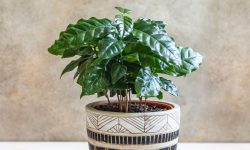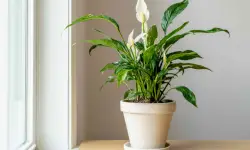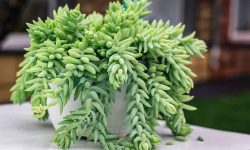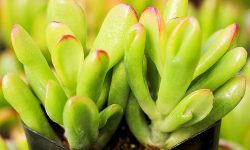The arrowhead plant is also known as syngonium, and it is the popular choice among houseplant enthusiasts. Proper Syngonium plant care will help you to get the best out of it and mark a bold statement in your indoor space.
Arrowhead plant leaves curling is an indicator of an underlying issue. We recommend examining your houseplant to identify the exact cause and fix it. Do not panic if you notice the leaves of your indoor Syngonium plant curling.
Underwatering and low humidity are the leading causes of Syngonium leaves curling. But there are other issues that might lead to the leaf problem. We wrote this article to share the causes and tips to revive an arrowhead plant with curling leaves.
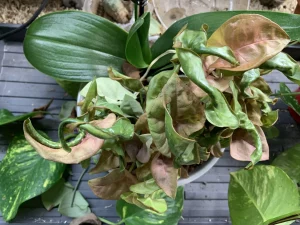
10 Causes of Arrowhead Plant Leaves Curling
Overwatering Problem
Overwatering is a common cause of arrowhead plant leaves curling. When the plant receives more water than it needs, the excess moisture leads to root rot, suffocating the roots and preventing them from absorbing nutrients effectively.
To revive curling arrowhead plant leaves due to overwatering, it’s crucial to adjust the watering routine. Assess the soil’s moisture level by inserting a finger about an inch deep into the soil. Allow the top inch or so of the soil to dry out before watering again.
Ensure the plant is in a well-draining pot with drainage holes to prevent water from pooling at the bottom. If the soil is heavily waterlogged, consider repotting the arrowhead plant into fresh, well-draining soil.
Trim off any yellow or brown leaves to redirect energy to healthier foliage. Place the plant in a location with bright, indirect light to encourage new growth. Adjusting the watering frequency and allowing the soil to dry between waterings will help the plant.
Underwatering Issue
Underwatering can also cause arrowhead plant leaves to curl. When the plant doesn’t receive sufficient water, it becomes dehydrated, and the leaves curl as a protective measure to minimize moisture loss.
Underwatering affects the plant’s ability to absorb nutrients properly, further exacerbating leaf curling. To revive curling arrowhead plant leaves due to underwatering, it’s essential to adjust the watering schedule.
Check the soil moisture regularly by inserting a finger into the soil. If it feels dry or slightly moist, it’s time to water the plant. Water thoroughly until it drains out of the bottom, ensuring the entire root ball is adequately moistened.
Increase the humidity around the plant by placing it on a tray filled with water and pebbles or using a room humidifier. Mist the leaves occasionally to provide additional moisture.
Inspect the plant for any signs of root rot, which can occur if the plant has been underwatered for an extended period. If root rot is present, trim off any affected roots and repot the plant in fresh, well-draining soil.
Ensure the arrowhead plant receives bright, indirect light, but avoid placing it in direct sunlight, as it can further stress the dehydrated plant. With proper watering and increased humidity, the arrowhead plant’s leaves should gradually unfurl and regain their healthy appearance.
Incorrect Lighting
Incorrect lighting conditions can lead to arrowhead plant leaves curling. Insufficient light causes the plant to stretch and become leggy, resulting in weak, curled leaves. On the other hand, exposing the arrowhead plant to direct sunlight can scorch the leaves, causing them to curl and brown.
To address curling arrowhead plant leaves caused by incorrect lighting, it’s important to provide the plant with the right light conditions. Place the arrowhead plant in a well-lit area away from direct sunlight, such as an east-facing or north-facing window.
If natural light is limited, use artificial grow lights, preferably full-spectrum fluorescent or LED lights, to supplement the plant’s lighting needs.
Rotate the plant periodically to ensure all sides receive equal light exposure, preventing uneven growth and curling leaves. Avoid placing the plant in dimly lit areas or rooms with no windows, as it can lead to prolonged leaf curling.
Maintaining consistent lighting conditions and ensuring the arrowhead plant receives adequate bright, indirect light will promote healthy leaf growth and prevent further curling.
Lack of Humidity
A lack of humidity can contribute to arrowhead plant leaves curling. Arrowhead plants originate from tropical regions with high humidity, and when they are exposed to dry air, the leaves tend to curl as a response to water loss.
Increasing the moisture in the surrounding air to revive curling arrowhead plant leaves due to low humidity. You can use a room humidifier near the plant to raise humidity levels. Alternatively, create a humidity tray by placing the plant on a tray filled with water and pebbles.
Mist the arrowhead plant’s leaves regularly with room-temperature water to provide additional moisture. Avoid misting excessively, as it can promote fungal diseases. Grouping plants together can create a microclimate with increased humidity.
Maintain a consistent watering schedule, ensuring the soil is adequately moist but not waterlogged. Providing proper humidity levels alongside regular watering will help revive curling arrowhead plant leaves and promote healthy growth.
Overfertilization
Overfertilization can cause arrowhead plant leaves to curl. When the plant is given an excessive amount of fertilizer or if it’s applied too frequently, it can lead to a buildup of salts in the soil. These salts can cause dehydration and nutrient imbalances, resulting in leaf curling.
To revive curling arrowhead plant leaves due to overfertilization, flush the soil with plain water to remove any excess salts. Water the plant thoroughly until water drains out of the bottom of the pot, repeating this process a few times to leach out the accumulated salts.
Allow the plant to dry out slightly before resuming a regular watering schedule. It’s important to use a balanced, water-soluble fertilizer specifically formulated for houseplants and follow the recommended dosage instructions.
Extreme Temperature
Extreme temperature conditions can cause arrowhead plant leaves to curl. Exposure to excessively high or low temperatures can stress the plant and result in leaf curling. High temperatures can lead to increased evaporation and dehydration, while cold temperatures can hinder the plant’s metabolic processes.
To revive curling arrowhead plant leaves caused by extreme temperatures, ensure the plant is kept in a temperature range of 60-75°F (15-24°C). Avoid placing the plant near drafts or areas with extreme temperature fluctuations, such as next to heating or cooling vents.
Provide adequate insulation during cold weather by moving the plant away from cold windows or using curtains to prevent cold drafts. In hot weather, shield the plant from direct sunlight and provide shade if needed.
Maintaining a stable temperature and avoiding sudden temperature changes will help the arrowhead plant recover from leaf curling. If the leaves are severely damaged, you may need to prune them off and allow new, healthy growth to emerge.
Root-Bound Arrowhead
A root-bound arrowhead plant, where the roots have outgrown the current pot, can lead to leaf curling. When the plant becomes root-bound, the roots become congested and start circling the pot, restricting the plant’s ability to absorb water and nutrients adequately.
To revive curling arrowhead plant leaves due to being root-bound, carefully remove the plant from its pot and examine the root system. If you see a dense mass of roots circling around the root ball, it’s time to repot the plant into a larger container.
Gently loosen the roots and trim any excessively long or damaged roots. Select a pot that is one size larger with drainage holes. Fill it with fresh, well-draining potting soil. Place the plant in the new pot, ensuring the roots are spread out and covered with soil.
Water the plant thoroughly after repotting and continue with a regular watering schedule. The arrowhead plant will have room to grow, and the improved root system will support healthy leaf development, reducing curling.
Syngonium Leaf Curling after Repotting
Arrowhead plants (Syngonium) can experience leaf curling and drooping after repotting due to transplant shock. Repotting can disrupt the plant’s root system and temporarily affect its ability to absorb water, resulting in wilting and curling leaves.
To revive curling arrowhead plant leaves after repotting, provide proper care and support during the recovery period. Place the plant in a location with bright, indirect light and away from direct sunlight. This helps minimize stress on the plant while it adjusts to its new environment.
Ensure the arrowhead plant receives adequate water, but avoid overwatering, as it can further stress the plant. Allow the soil to dry slightly between waterings, and then water thoroughly, ensuring proper drainage.
Maintain a consistent humidity level around the plant by misting the leaves regularly or using a humidity tray with water and pebbles.
Avoid fertilizing the plant immediately after repotting, as it can add further stress. Wait for a few weeks before resuming a regular fertilization schedule.
With time and proper care, the arrowhead plant will recover from transplant shock, and the curling leaves will gradually regain their healthy appearance.
Pest Infestation
Pest infestations, such as spider mites, aphids, or mealybugs, can cause arrowhead plant leaves to curl. These pests feed on the plant’s sap, causing stress and damage to the leaves, which can result in curling, discoloration, and distortion.
To revive curling arrowhead plant leaves caused by pest infestation, identify and treat the pests promptly. Inspect the plant thoroughly, paying close attention to the undersides of leaves and leaf joints, where pests tend to hide.
Depending on the type of pest, you can use insecticidal soap, neem oil, or a gentle pesticide specifically formulated for houseplants. Follow the product instructions carefully and treat the plant accordingly. Repeat the treatment if necessary, ensuring all the pests are eliminated.
After treating the infestation, gently clean the leaves with a damp cloth to remove any pests or residue. Maintain good plant hygiene by regularly inspecting the plant for any signs of pests and promptly addressing any issues.
Acclimation
When an arrowhead plant is moved from one environment to another with different light, temperature, or humidity conditions, it can undergo acclimation stress. This stress can cause the leaves to curl temporarily as the plant adjusts to its new surroundings.
To help the arrowhead plant acclimate and revive curling leaves, ensure it is placed in an environment that closely matches its ideal conditions. Gradually introduce the plant to new light levels, temperature ranges, and humidity levels over a period of several days or weeks.
Monitor the plant closely during this acclimation period and make adjustments as needed. Maintain consistent watering practices, ensuring the soil is adequately moist but not overly saturated.
Provide gentle misting or increase humidity around the plant to alleviate stress and prevent excessive leaf curling.
Final Thoughts from Experts
Syngonium plant leaves curling is a common phenomenon. The best option is to examine your houseplant to identify the exact cause since there are several reasons behind it. Dealing with Syngonium leaf problems can be a daunting experience among beginners.
Learning how to care for arrowhead plants is the only technique to avoid leaf problems. We hope the above information will help you unfurl curled leaves on your arrowhead plant. If your arrowhead plant leaves curling is not resolved, let us know in the comment.
People Who Read This Also Read:



